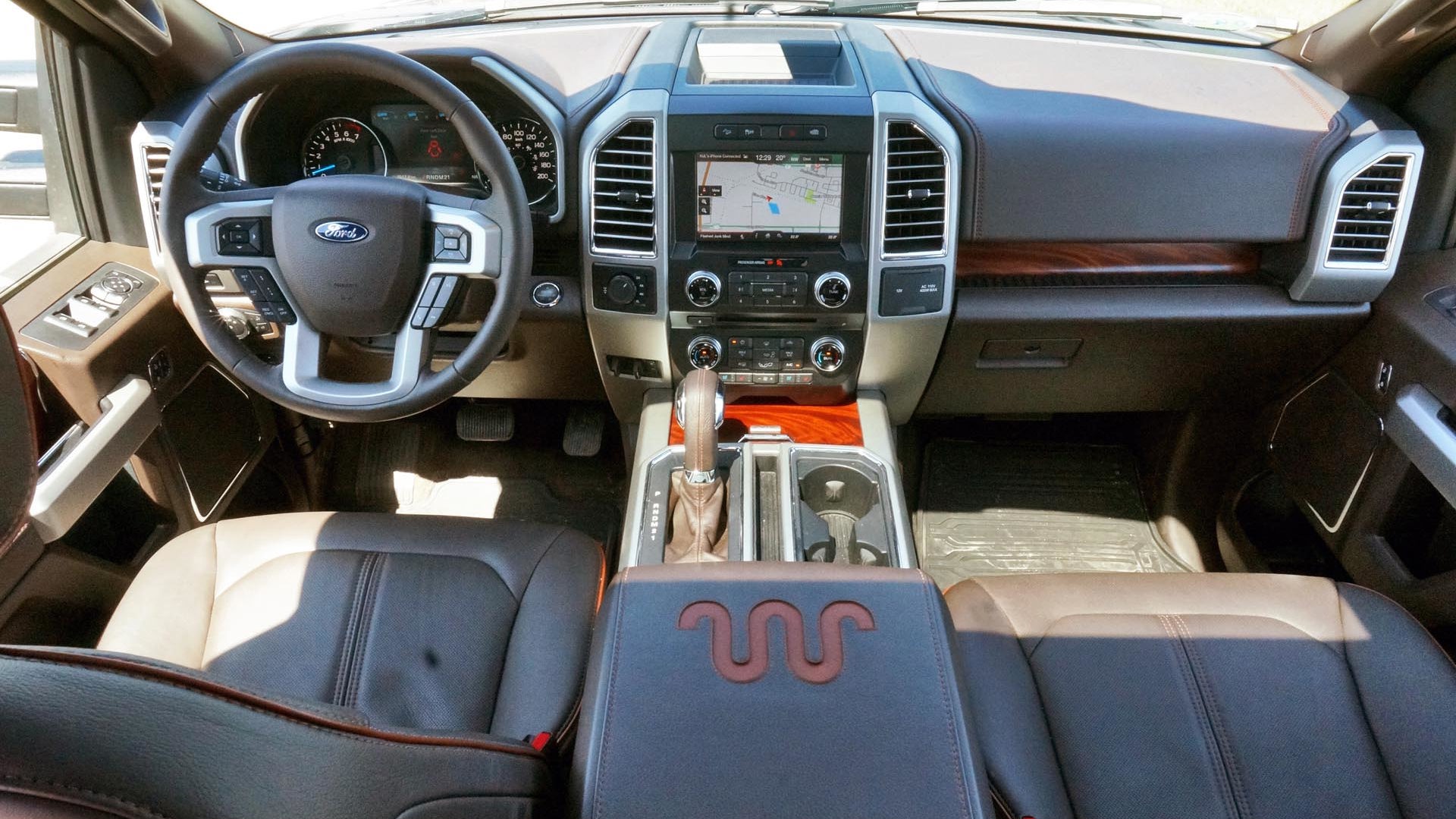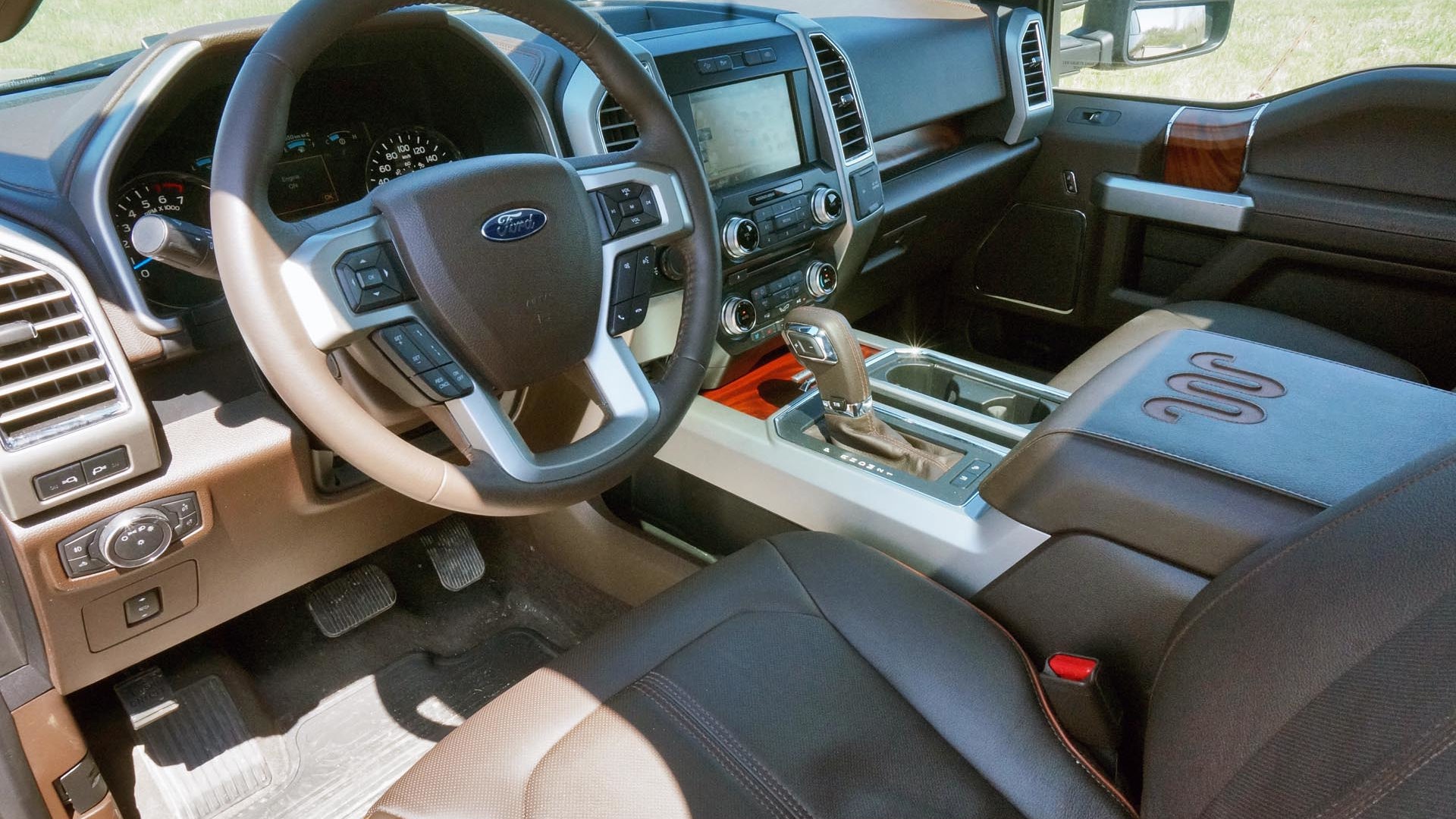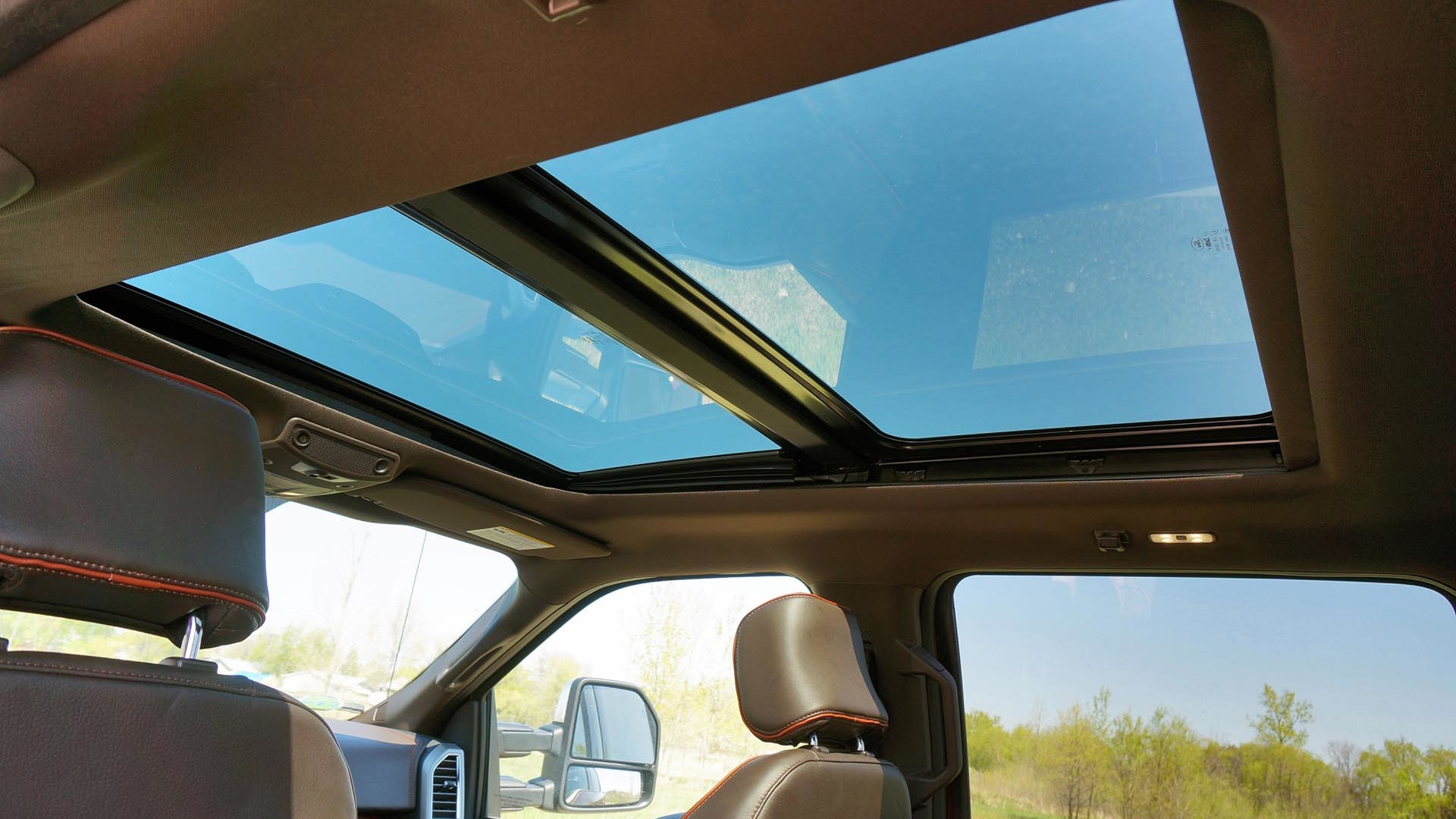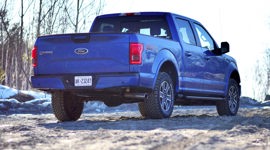It’s no secret by now that the 2015 Ford F-150 pickup is chock full of innovation. Its aluminum body has garnered most of the headlines, but the truck is also ahead of the curve in a number of other areas.
As of the end of May, Ford has sold 48,868 F-150s in Canada this year.
Trucks have always been high-profit products for the automakers, and despite their historical primary function as workhorses, many have found their way into suburban garages (or driveways in most cases, since they won’t fit in the garage) as family vehicles. Their versatility has helped them become big sellers indeed: as of the end of May, Ford has sold 48,868 F-150s in Canada this year. It’s enjoying a healthy lead over its rivals from General Motors and Ram, and all of those models are a mile ahead of the country’s top-selling car, the Honda Civic at 23,559 units.
Now, I’ve never been a truck guy, preferring a car with nimble handling and more efficient use of power over the high seating position and utility that a full-sized truck can offer. But I consider myself to be an open-minded individual, so what better time to challenge my predispositions than during a long-weekend road trip south of the border to Minneapolis?
As has been the case for some time, the variations available in the Ford F-150 are nearly limitless. There are still basic full-sized trucks out there, and in Ford’s case that would be the $24,899 F-150 XL with a regular cab (no rear quarters), two-wheel drive and steel wheels. There is a standard equipment list but it’s not unlike that on the most basic of cars that cost half as much: air conditioning, AM/FM radio, tilt and telescoping wheel, intermittent wipers, capless fuel filler, trailer sway control, and that’s about it.
The $32,799 XLT includes many items today’s truck buyers expect: alloy wheels, CD player with satellite radio, Sync connectivity, power locks and windows, cruise control, carpet, chrome bumpers, power locking tailgate, power mirrors, automatic headlights, and keyless entry. But there’s still room for plenty of options. And boy, did our tester have options.
Above the XLT sit the Lariat, King Ranch and Platinum models. The Lariat starts at $48,599 and serves as the launching point for the top two models. This is where you’ll find things like four-wheel drive, bigger wheels, a 2.7-litre EcoBoost V-6, heated and cooled front seats, dual-zone climate control, MyFord Touch user interface with eight-inch screen, parking sensors and rear-view camera, BoxLink cargo management system, remote start, and a trailer towing package.
Our tester was the King Ranch version, which starts at an eye-popping $64,999, although at the time of this writing Ford was offering its patented “you have a pulse” discount of $4,500, dropping the price to a little more than sixty grand. Ford was liberal in checking the option boxes, though, and with such options as a panoramic roof, adaptive cruise control, and a technology package, the price crept up into the $70s.
Our truck was configured to do it all: the F-150 King Ranch is priced up there with some serious luxury machinery, but to some a truck manages to get by in a less ostentatious manner.
Cabs are offered in three varieties in the F-150; regular, Super Cab, and SuperCrew. The four-full-door SuperCrew is standard on King Ranch and Platinum models, as is the 66-inch box, though a 78-inch box is a no-cost option. With the standard box configuration, the F-150 SuperCrew measures 5,890 mm, or about 19 feet, four inches. That would be a challenge for many residential garages, and its 1,961-mm height (a little over six-foot-five) flirts with height restrictions at many indoor parking garages.
I only mention this in the context of using the F-150 as a daily driver. It’s big, and with each new generation of full size trucks, the so-called “light duty” versions are looking more and more like their heavy-duty brethren. In fact, people are downright shocked when I tell them this is “only” a 150. It didn’t help that our truck was equipped with power extending and folding trailer mirrors, easily increasing its width by another couple of feet over the width of the body alone.
As engines go, Ford offers a total of four gasoline mills in the F-150: a 3.5-litre naturally aspirated V6, turbocharged 2.7L and 3.5L EcoBoost V6s, and a 5.0L V8. But by the time you get into the King Ranch, only the 3.5 EcoBoost and five-point-oh are available. Ours was the five-litre; the 3.5 EcoBoost is a $900 option.
The 5.0 comes to the table with 385 hp and 387 lb-ft of torque and achieves a combined fuel consumption rating of 13.9 L/100 km. The overachieving boosted-six counters with 365 hp, 420 lb-ft, and 12.5 combined L/100 km. Which engine to choose will be debated on the forums until the end of time, but either would be a good choice, and as long as both are offered both will be chosen for various reasons.
Around town, the F-150 behaved much as I had expected. It’s an easy truck to drive; fairly maneuverable given its girth. The view over other traffic is a commanding one, and people tend to move out of the way quickly when all they see in their rearview mirrors is grille.
Like many of my F-150-driving neighbours, I live in the suburbs and drive downtown for work. And this is where the real question for me comes in: I have trouble with the notion of getting into a 2,200-kg truck to drive alone in stop-and-go traffic day in and day out. Where more efficient cars would complete my commute on 10 L/100 km or less, the same drive consumes nearly double the fuel in the F-150. Sure, it’s nice and everything, but there are better ways to skin that cat.
Regardless of the conspicuous consumption issue, driving and parking the F-150 downtown is not as difficult a task as one would expect. My parking garage accommodates vehicles up to 6’8”, so the only part of the truck getting intimate with the structure above is the antenna. Parking in tight spaces is difficult given the length and width of the truck, but the 360-degree camera in our tester’s tech package took all of the guessing out of placing the truck optimally within the space. I did, however, need to fold in the mirrors to get where I needed to go in there. Having them fold at the touch of a button made life easier in that respect.
Out on the open road, though, the F-150 came into its own.
First order of road-trip business: luggage storage. With May long weekend weather being notoriously unpredictable, I wasn’t about to let four suitcases and a bunch of other stuff fend for themselves in an open truck box. Plus, I wouldn’t be able to leave the truck parked anywhere if the luggage weren’t securely stowed. So, a request to Ford resulted in a folding tonneau cover being installed by Capital Ford Lincoln here in Winnipeg. There are several options available, both through the dealer and on the aftermarket, but the one chosen by Ford suited our purposes nicely. It’s a canvas cover over three fiberboard panels that can fold up over each other. This particular one is a tool-free installation that uses four quick-release clamps which are accessible only from underneath. So, with that and the power-locking tailgate, our stuff was safe. And at 1,495 L, the enclosed box volume is nearly perfectly rectangular and very commodious indeed.
The best way to describe the space within the F-150’s SuperCrew interior is like this: if you’ve ever felt the need to travel down the highway in your living room, the F-150 will suit you nicely. This is, without a doubt, the most spacious vehicle in which my family has ever travelled. The rear compartment is cavernous and the front seats are well designed for long hauls. This is especially important when the truck has a bladder-busting 136 L tank.
With its brown-piped leather seats and wood trim I normally would dismiss the interior of the King Ranch as tacky and overwrought, but again, Ford has made this combination work in a tasteful and genuinely luxurious manner. The wood is real and its use is restrained. The impression of the cabin is one of high quality and taste. I know; who would’ve thought?
It’s not just the space that makes this truck a good highway companion, though. Despite having aerodynamic properties on par with a Rubik’s cube (aided only slightly by the presence of the tonneau cover), wind noise was pleasantly subdued, even while humming along at Interstate 29’s 75 mile-per-hour (120 km/h) speed limit. Such serenity within the passenger compartment allowed us to enjoy the 700-watt Sony audio system, which has no fewer than ten speakers plus a subwoofer.
And that brings us to the user interface that permits operation of said audio system: Ford’s Sync with MyFord Touch is simply one of the best automotive user interface systems on the market. After enduring offerings from Honda/Acura and wondering how such a scattered system made it into production in the 21st century, it’s just a pleasure to get into a Ford and use a system that just works. Seems too much to ask sometimes, but these folks have it figured out.
Let’s start with the screen: it’s operated by touch, not by some remote knob-and-menu system that takes attention away from the driving task at hand. And it’s organized into quadrants; a touch in any of the corners of the screen will change modes between navigation, entertainment, communication, and climate. It’s also much more responsive than the MyFord Touch of old, so it’s quicker on its feet. Voice commands are routinely recognized properly and the whole experience makes one realize that it doesn’t have to be a chore trying to get the system to do what you want.
Key to a successful user interface design is the recognition that some functions should still be operated using actual physical buttons on the dash, and here Ford shines as well. Audio system on/off and volume are operated using an honest-to-goodness knob on the dash, as are the radio tune and climate controls. Radio presets, climate functions, and seat heating and cooling get their own buttons too. Sure, this creates some redundancy and to some may defeat the purpose of having a touch screen, but trust me: this is how it is and should be done. Maximum function, minimum distraction.
So the F-150’s highway manners are well suited to gobbling up miles of interstate, so long as one can stomach the fuel bills along the way. The trip down to Minneapolis yielded an average consumption in the low 14s, as compared to an official rating of 11.3 L/100 km. That’s with the cruise seated firmly in the 120 km/h (and up) range. The trip back wasn’t quite so good, causing the average to climb to 15.3 for the whole trip thanks to a stiff 40 km/h (plus gusts) headwind. In short, the truck consumed nearly three times as much fuel as my VW diesel wagon has on this trip.
But other than that significant drawback, the big Ford performed its duties admirably, with full acknowledgment that it didn’t even break a sweat. Let’s not forget this machine can carry a payload of 1,320 kg or tow 5,400 kg. Somehow the term “light duty” no longer seems fitting.
So the F-150 did well for us, but I can’t help but wonder what I would get for the same money. My dollars would be spent on something like an Audi Q7 diesel that has gobs of torque and can tow a yacht. To each their own. Functionally, though, Ford makes a strong case for the F-150 as a do-it-all vehicle for today’s families.
| Warranty: 3 years/60,000 km; 5 years/100,000 km powertrain; 5 years/unlimited distance corrosion perforation; 5 years/100,000 km roadside assistance Competitors: |
| Model Tested | 2015 Ford F-150 King Ranch |
|---|---|
| Base Price | XL: $24,899 King Ranch: $64,999 |
| A/C Tax | $100 |
| Destination Fee | $1,700 |
| Price as Tested | $75,244 |
|
Optional Equipment
$8,445 (601A – $2,500 (tailgate step, BLIS with cross-traffic alert, automatic high beams, 20-inch wheels, inflatable rear seat belts); FX-4 Off-Road package – $750 (3.31 electronic locking differential, hill descent control, off-road suspension, skid plates); technology package – $1,250 (360-degree camera, lake keep assist); plastic drop-in bedliner – $395; box side steps – $300; twin panel moonroof – $1,750; adaptive cruise control – $1,500)
|
|




































